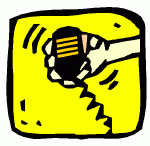 Well, that’s what the FCC says: the Amateur Radio Service is not an emergency radio service. K1ZZ’s QST editorial quotes the FCC and points out that the mission of the Amateur Radio Service is indeed broader than emergency communications. (The FCC does recognize the role that amateur plays in emergencies — see this web page.)
Well, that’s what the FCC says: the Amateur Radio Service is not an emergency radio service. K1ZZ’s QST editorial quotes the FCC and points out that the mission of the Amateur Radio Service is indeed broader than emergency communications. (The FCC does recognize the role that amateur plays in emergencies — see this web page.)
Lately, I’ve noticed a number of blog postings and other statements from hams that define amateur radio way too narrowly. The common thread is taking the part of ham radio that is most important to them and arguing that Real Ham Radio is focused on that segment of the hobby/radio service.
For some folks, amateur radio is emergency communications (only). Others argue that only technical pursuits are true ham radio and those appliance operators are just holding us back. For others, ham radio is defined by getting on the air and operating (might be QRP, might be contesting, might be something else).
I think K1ZZ got it right….the purpose is broader than that. Just go read Part 97.1 of the FCC rules:
The rules and regulations in this Part are designed to provide an amateur radio service having a fundamental purpose as expressed in the following principles:
(a) Recognition and enhancement of the value of the amateur service to the public as a voluntary noncommercial communication service, particularly with respect to providing emergency communications.
(b) Continuation and extension of the amateur’s proven ability to contribute to the advancement of the radio art.
(c) Encouragement and improvement of the amateur service through rules which provide for advancing skills in both the communications and technical phases of the art.
(d) Expansion of the existing reservoir within the amateur radio service of trained operators, technicians, and electronics experts.
(e) Continuation and extension of the amateur’s unique ability to enhance international goodwill.
Let’s reject the narrow view and think a bit broader.
73, Bob K0NR
 We completed our second attempt at the Technician License Class. The format we are using is two all day Saturday sessions, supplemented by self-study using the Gordon West book. We had 14 people take the Technician exam (Element 2), with 13 passing (93% pass rate). We had 4 Boy Scouts in the group and they all passed. (Their troop is getting quite a few Scouts with licenses and they are having a blast with it on camp outs.)
We completed our second attempt at the Technician License Class. The format we are using is two all day Saturday sessions, supplemented by self-study using the Gordon West book. We had 14 people take the Technician exam (Element 2), with 13 passing (93% pass rate). We had 4 Boy Scouts in the group and they all passed. (Their troop is getting quite a few Scouts with licenses and they are having a blast with it on camp outs.)
 The
The  I’ve
I’ve  Things have gotten a little busy for me, so sorry about going dark on blog postings. I had several weeks of business travel, followed by a wonderful trip to the Caribbean. Unfortunately, no ham radio action on any of these trips.
Things have gotten a little busy for me, so sorry about going dark on blog postings. I had several weeks of business travel, followed by a wonderful trip to the Caribbean. Unfortunately, no ham radio action on any of these trips. We finished up the second and last day of our 2-day
We finished up the second and last day of our 2-day  Part 97.113 has been the topic of much discussion lately, ever since the FCC communicated a rather narrow interpretation of the rules. See
Part 97.113 has been the topic of much discussion lately, ever since the FCC communicated a rather narrow interpretation of the rules. See  Wow, the interest in the
Wow, the interest in the 
 Well, that’s what the FCC says: the Amateur Radio Service is not an emergency radio service. K1ZZ’s
Well, that’s what the FCC says: the Amateur Radio Service is not an emergency radio service. K1ZZ’s 
 We’ve been looking at optimizing the performance of the D-STAR repeater here in Monument (
We’ve been looking at optimizing the performance of the D-STAR repeater here in Monument ( The results of the Colorado QSO Party have been posted on the PPRAA web site. I had previously
The results of the Colorado QSO Party have been posted on the PPRAA web site. I had previously